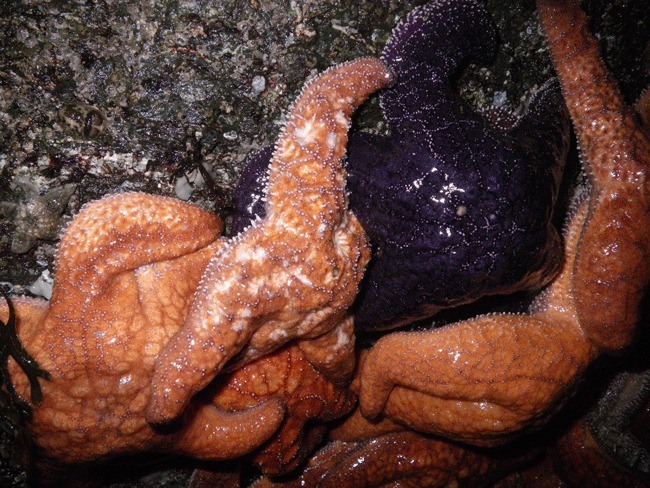Back-to-back talks at the Orcas Library on the sand dollars and sea stars of East Sound round off this summer’s public programs of the Indian Island Marine Health Observatory and Kwiaht.
The event is on Friday, Sept. 5 from 3:30 to 5:30 p.m. The presenters are Amy Henry, a University of Chicago doctoral candidate in evolutionary biology; and Russel Barsh, director of the local nonprofit conservation biology laboratory, Kwiaht.
Henry leads off with an update on her sand dollar experiments at Crescent Beach, now in their second year. The beach has extensive eelgrass meadows as well as the largest concentration of sand dollars in the county.
Sand dollars and eelgrass seem incompatible: only one or the other is found within any particular patch of sand. If part of the beach is disturbed by a storm or human activity, which returns first, eelgrass or sand dollars? What factors determine the outcome of the race?
Barsh follows with a review of the impact of Sea star Wasting Syndrome at Indian Island and prospects for recovery. Thousands of Ochre Stars converge at Indian Island each year to feast on shellfish and to spawn. This year, up to 90 percent of them died from the syndrome, mainly during July. What can we expect in 2015? Is this a seastar apocalypse, or an example of parasites and disease serving a periodic regulatory function in ecosystems? Clues can be found in studies of two previous outbreaks on the Pacific Coast, as well as data collected at Indian Island this summer.
If you find sand dollars and sea stars beautiful, mysterious, or strange, come to the “Echinoderm Double-Header” on Sept. 5.
For more information on the event, send an email to kwiaht@gmail.com.
The event is on Friday, Sept. 5 from 3:30 to 5:30 p.m. The presenters are Amy Henry, a University of Chicago doctoral candidate in evolutionary biology; and Russel Barsh, director of the local nonprofit conservation biology laboratory, Kwiaht.
Henry leads off with an update on her sand dollar experiments at Crescent Beach, now in their second year. The beach has extensive eelgrass meadows as well as the largest concentration of sand dollars in the county.
Sand dollars and eelgrass seem incompatible: only one or the other is found within any particular patch of sand. If part of the beach is disturbed by a storm or human activity, which returns first, eelgrass or sand dollars? What factors determine the outcome of the race?
Barsh follows with a review of the impact of Sea star Wasting Syndrome at Indian Island and prospects for recovery. Thousands of Ochre Stars converge at Indian Island each year to feast on shellfish and to spawn. This year, up to 90 percent of them died from the syndrome, mainly during July. What can we expect in 2015? Is this a seastar apocalypse, or an example of parasites and disease serving a periodic regulatory function in ecosystems? Clues can be found in studies of two previous outbreaks on the Pacific Coast, as well as data collected at Indian Island this summer.
If you find sand dollars and sea stars beautiful, mysterious, or strange, come to the “Echinoderm Double-Header” on Sept. 5.
For more information on the event, send an email to kwiaht@gmail.com.



